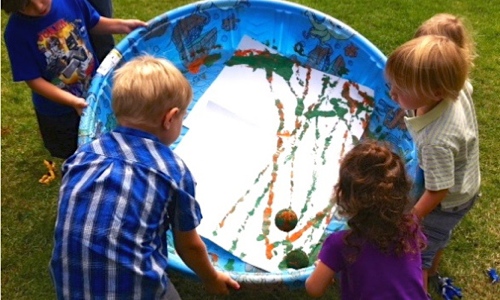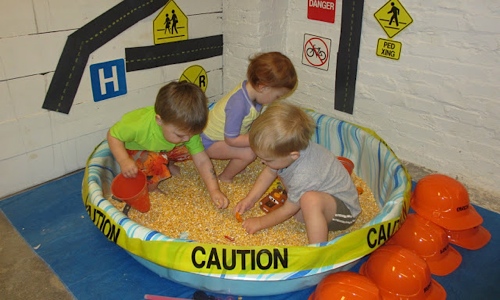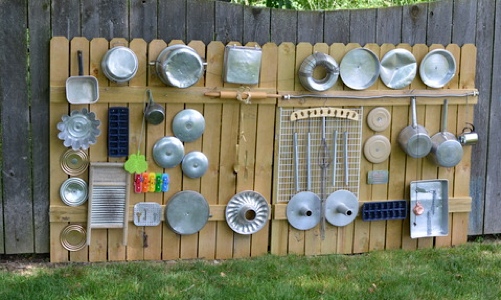How to Host a Sensory Play Party for Visually Impaired Kids
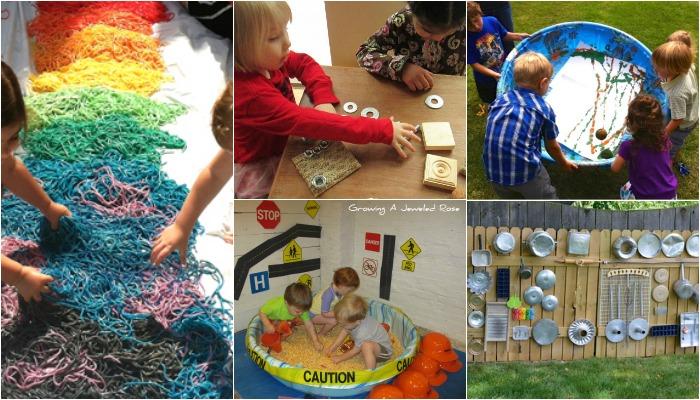
This post may contain affiliate links; please see our terms of use for details.
Sensory Play and Multi-Sensory Activities are such buzzwords these days. Early educators and special needs moms alike know how important it is to engage a child’s senses during play in order to encourage learning and development. But have you ever noticed that most sensory play activities are designed for one kid to play alone, usually while sitting nicely at a table?
If your child is a mover and a shaker, that might not be realistic. Plus it’s also really important for us to engage our children in social play, especially if our kids have a disability. So why not throw a sensory play party? And what would that look like?
- What is Sensory Play?
- Why are Group Activities Important?
- How to Make Activities Accessible
- 5 Fun Games for Your Sensory Play Party
What is Sensory Play?
Sensory play is any activity that stimulates the senses: touch, smell, taste, sight and hearing. And multi-sensory play engages more than one sense at a time. When children spend time stimulating their senses they develop cognitively, linguistically, socially and emotionally, physically and creatively. Both children and adults learn better and retain more when their senses are engaged during the learning process.
But what if your child has a sensory impairment like blindness? Should you still search out sensory play activities? Absolutely! It’s important for children who are blind to participate in sensory play because it will help build their other senses and allow for sensations that may be directed by one sense (like sight) to be directed by another (like touch). For example, a sighted child may learn quickly that something is rough or pokey just by looking at it, but a visually impaired child will have to touch (and touch and touch) to get that same information.
Sensory play is also a really great way to build language skills for kids who are blind. Without touching something slimy, for example, it would be very difficult to understand what the word slimy means, especially if you couldn’t see.
Why are Group Activities Important?
Group activities can teach a child how to:
- be kind
- be confident
- be productive
- resolve conflicts
- make friends
- respect others
- communicate
- develop positive feelings about others
- develop team spirit
- work collaboratively
- share ideas
- take on responsibilities
- share and take turns
- foster healthy competition
How to Make Activities Accessible
There are so many ideas for fun sensory activities on Pinterest or in parenting magazines, but they rarely take disability into consideration. Rather than passing on an activity that seems too visual or otherwise inaccessible for your child, try putting your creative cap on and developing more accessible alternatives!
 Pick the right colors
Pick the right colors
Many kids with low vision or CVI are drawn to certain colors, like yellow or red. Try changing the colors in the activity to match the colors your child responds to best.- Use high contrast
Playing with cheerios? How about placing them on a black mat? Finger painting with chocolate pudding? Now it’s time to play on a white surface! Try to come up with ways to bring in more contrast when setting up an activity for a child with low vision. - Reduce clutter
Sensory bins are great ways to introduce textures and smells, but they can also be extremely visually cluttered. When setting up your own bin you could reduce the number of objects and colors in the bin and also try to keep the filler material simple, like white rice or sand. - Add sounds
Another way to keep an activity accessible is to add sound. If you’re rolling a ball back and forth, for example, try putting a jingle bell or marbles in the ball so it makes a sound. Attaching jingle bells to other objects can also help add audio input and also help your child locate the object.  Add textures
Add textures
This is where a trip to the fabric store’s remnant bin can save the day! Grab felt, corduroy, satin, faux fur and whatever else you can find. Now you can use these materials to add different textures to objects so your child can distinguish them when playing. For example, if you are playing with blocks you could attach felt to each red block and fur to each yellow block. Now your child has another way to tell them apart!- Use puffy paint
When an activity calls for paint, replace that with puffy paint so your child can feel their art when it dries. You can also color with crayons on paper that is placed over a screen so the lines are bumpy! - Make it edible
Does your kid put everything in their mouth? Mine too! Whenever possible we try to play with items that are safe to mouth or (better yet) safe to eat. For example, instead of using water beads in your sensory activity, try tapioca pearls! - Get a handle on it
If a toy or object is difficult for your child to pick up, maybe you can add a drawer pull or handle. For example, large wooden puzzle pieces can be difficult for some kids to hold on to, but if you drill a hole and add a simple drawer pull it’s much easier! - Add a switch
Playing a game that requires your child to respond with a rhyme or an answer? If your child is nonverbal you could record the response on a switch and let them push the switch when it’s their turn to speak!
5 Fun Games for Your Sensory Play Party
So now it’s time to plan your party! Here are five fun activities you could play with your friends to get the sensory juices flowing!
#1. Make a Comparing Bag
This simple activity involves a trip to your local hardware store and only a little imagination. Using bolts, carpet swatches, washers and pretty much anything else you can find, you can create a fun tactile find-and-match game that is perfect for young children to play together.
#2. Tennis Ball Painting
Place a tennis ball in a kiddie pool along with paint and a large piece of paper and see what kind of art you can create by tilting the pool back and forth. Add a tactile element to your artwork with puffy paint or add sand to your paint.
#3. Rainbow Noodles Party
Use food coloring to add color to spaghetti noodles then lay the colored noodles out on a large white tarp for edible and squishy sensory play!
#4. LARGE Sensory Bins
Sensory bins are usually small (like in a tupperware container) so you can put your hands in them, but why not make a really, really big one out of a kiddie pool? Pick a theme (this one is construction) and a base (this one uses dry corn kernels) and let your kids get their whole bodies in the bin!
#5. Backyard Music Wall
Hit a couple of garage sales for old pots, pans and trays and you’re ready to create a backyard music wall for your child and his friends. Invite a group of kids over, hand out some wooden spoons and let the symphony begin!
Whatever you decide to do, remember to keep it fun and stress-free. Sensory play is often synonymous with MESSY play, so you’ll have to be ok with there being quite a bit of mess around your house. If you can set up the party out doors, that makes for easier clean up… but then again, hosting a sensory play party in the winter sure could shake those winter blues!
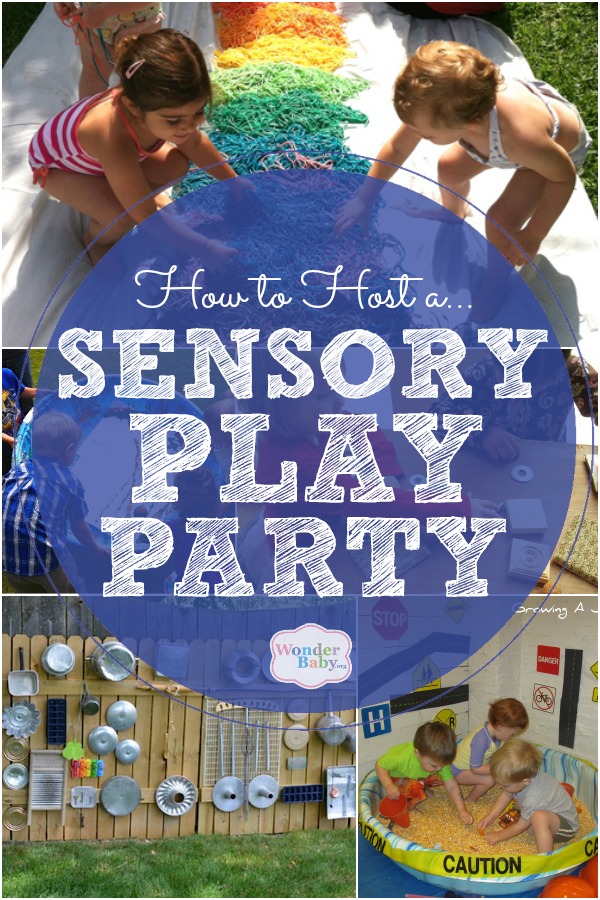
Related Posts

Eye Conditions and Syndromes, Visual Impairment
Neuralink Announces Plans to Restore Sight to the Blind with Brain Chip
Elon Musk’s company Neuralink has announced plans to begin human trials of its new “Blindsight” brain chip by the end of 2025.

Visual Impairment
The Gift of Understanding: How a Young Child Helps His Blind Father Navigate Life
When a parent is blind, it’s natural for people to wonder how their sighted child will adapt. Will they struggle to understand their parent’s needs? Will they feel burdened by...

Braille and Literacy, Toys, Visual Impairment
24 Braille Toys for Kids Who are Blind
Everything from alphabet blocks to raised line coloring pages and activity books to puzzles to card and board games... and so much more! And it's all in braille ready for...

